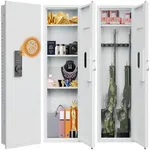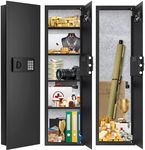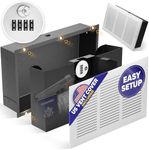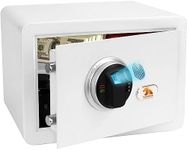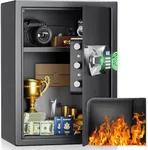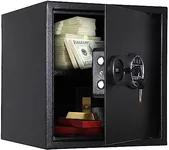Buying Guide for the Best In-Wall Safes
Choosing the right in-wall safe is crucial for ensuring the security of your valuables, important documents, and other personal items. In-wall safes are designed to be installed between the studs of your wall, making them less conspicuous and more secure than traditional safes. When selecting an in-wall safe, it's important to consider several key specifications to ensure you get the best fit for your needs. Here are the key specs to look out for and how to navigate them.Size and CapacitySize and capacity refer to the dimensions of the safe and the amount of space available inside for storing items. This spec is important because it determines what and how much you can store in the safe. In-wall safes come in various sizes, from small models suitable for documents and small valuables to larger ones that can accommodate more items. To pick the right size, consider what you plan to store in the safe. If you only need to store documents and small items, a smaller safe will suffice. However, if you have larger items or a significant number of valuables, opt for a larger capacity safe.
Locking MechanismThe locking mechanism is the method used to secure the safe and prevent unauthorized access. This spec is crucial for the security of your items. Common locking mechanisms include key locks, combination locks, electronic keypads, and biometric locks. Key locks are simple and reliable but can be less convenient if you lose the key. Combination locks don't require keys but can be slower to open. Electronic keypads offer quick access and can be programmed with multiple codes, while biometric locks provide high security with fingerprint recognition. Choose a locking mechanism based on your preference for convenience and security. For high-security needs, biometric or electronic keypads are recommended.
Fire and Water ResistanceFire and water resistance refer to the safe's ability to protect its contents from fire and water damage. This spec is important if you want to ensure your valuables are protected in case of a fire or flood. Fire-resistant safes are rated by the amount of time they can withstand high temperatures, typically ranging from 30 minutes to several hours. Water-resistant safes are designed to keep water out, protecting contents from flooding or water damage. If you live in an area prone to fires or floods, or if you want extra peace of mind, look for safes with high fire and water resistance ratings.
Installation and MountingInstallation and mounting refer to how the safe is installed and secured within the wall. This spec is important for ensuring the safe is properly secured and difficult to remove. In-wall safes are designed to fit between standard wall studs, but the installation process can vary. Some safes come with pre-drilled holes and mounting hardware for easier installation, while others may require professional installation. Consider your DIY skills and whether you prefer to install the safe yourself or hire a professional. Proper installation is key to ensuring the safe is secure and effective.
Construction MaterialConstruction material refers to the materials used to build the safe, which affects its durability and security. This spec is important because it determines how resistant the safe is to tampering and physical attacks. Common materials include steel, composite materials, and reinforced concrete. Steel is the most common and offers good protection, with thicker steel providing more security. Composite materials and reinforced concrete can offer additional protection against drilling and cutting. Choose a safe with high-quality construction materials to ensure maximum security for your valuables.
Interior FeaturesInterior features refer to the design and organization of the inside of the safe. This spec is important for maximizing the usability and convenience of the safe. Features can include adjustable shelves, drawers, and compartments to help organize your items. Some safes also have interior lighting for better visibility. Consider what you plan to store and how you want to organize it. Adjustable shelves and compartments can be useful for storing a variety of items, while interior lighting can make it easier to find what you need.

